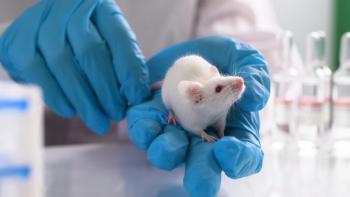- The distal end of the wire has a flexible J-tip to prevent puncturing the vessel.
- Feed the guide wire approximately two-thirds to three-quarters of its length into the vessel.
- Place sterile gauze over the insertion site with a slight amount of pressure while removing the insertion needle or short over-the-needle-catheter to prevent blood loss
- Never let go of the wire.
Step 7: Thread the vessel dilator over the wire.
Step 8: Grasp the dilator near the distal tip and advance it into the vessel using a forward, twisting motion.
- The skin entry site may need to be enlarged using a scalpel blade (RVT or DVM only).
- Minimize cutdowns; larger cutdowns increase the risk of bacterial colonization.
Step 9: Remove the vessel dilator while still holding the wire.
Step 10: Place sterile gauze over the insertion site with a slight amount of pressure while removing the vessel dilator to prevent blood loss.
Step 11: Remove the cap from the distal (brown) port of the catheter and ensure it is not clamped.
Step 12: Thread the multilumen catheter over the wire until the proximal end of the wire protrudes from the port.
Step 13: While holding the distal end of the guide wire, advance the catheter into the vessel until the desired distance is achieved (as determined by the previous measurement).
Step 14: While holding the catheter in place, remove the guide wire.
Step 15: Attach a syringe of sterile 0.9% NaCl to the port and aspirate blood to ensure proper placement and remove any air bubbles.
- Flush open port, clamp and then place the infusion cap on the end.
- Repeat with all ports.
Step 16: Suture the catheter to the skin using the plastic clamps with sterile needle drivers (Figure 2).
- All single or multilumen CVCs should be sutured in.
- If the catheter is too long, place the provided spacers over the exposed catheter before suturing.
Step 17: Take a lateral placement radiograph to ensure proper placement of the tip of the catheter (Figures 3a, 3b, and 4).
Step 18: Cover the site with a small nonadherent pad and small Tegaderm (avoid ointments).
- The bandage should be firm, but never tight.
- Peripheral catheters:
- Wrap with cast padding, stretch gauze, and vet wrap.
- Jugular catheters (Figure 5):
- Wrap with cast padding, followed by vet wrap.
- Do not use stretch gauze.
- Secure lumens with tape so they don’t get caught on anything.
Maintenance
Step 1: Wipe injection ports with alcohol before using.
Step 2: A 250-mL bag should be labeled when first punctured "For this patient's use only"; it expires in 72 hours (please refer to hospital policies regarding sampling).
Step 3: Flush CVC with sterile 0.9% NaCl every 6 hours.
- Unwrap bandage and visualize insertion site every 24 hours (change bandage).
- Check for signs of phlebitis/infection/dislodgment, redness, swelling, heat or discharge and notify the doctor of any abnormalities.
- If a portion of the catheter becomes visible and has pulled out from the insertion site:
- Aseptically clean the area with 2% chlorhexidine solution.
- Place spacers on top of the exposed catheter.
- Do not reinsert the catheter back into the vessel.
Step 4: When a patient is disconnected from intravenous (IV) fluids, a new male adapter should be used to cover the CVC hub and cap the fluid line with the other end of the male adapter.
Step 5: There is no need to remove the CVC unless signs of phlebitis/infection/dislodgement occur.
Step 6: Evaluate the need for a catheter and remove it as soon as it is no longer necessary to decrease the chances of bloodstream infection.
Removing the catheter
Step 1: Using 2% chlorhexidine solution, followed by sterile 0.9% NaCl, clean a circular area 2 inches in diameter around the insertion site, beginning at the insertion site and moving outward. This reduces microbial skin contaminants from migrating into the site.
Step 2: Withdraw CVC slowly in 1 continuous motion.
- Stop if resistance is met: The catheter may be knotted or lodged in the vessel. Secure the CVC, cover the site, and report to the physician.
Step 3: Place pressure on the site with clean gauze dressing until hemostasis is achieved; 1 to 5 minutes is suggested.
Step 4: Apply clean gauze dressing, cover with a transparent film dressing, wrap with cast padding, then use vet wrap to prevent air emboli.
Step 5: Leave the bandage in place for about an hour.
Indications
- Long-term IV access
- Multiple fluid lines/IV medications
- Serial blood sampling
- Lack of peripheral access
Contraindications
- Bleeding disorders
- Coagulopathies/thrombocytopenia
- Increased intracranial pressure: potential for decreased venous drainage during placement
Jenn Bench, RVT, VTS (ECC), T-CCFP, discovered her passion for veterinary emergency and critical care while completing her externship at a specialty emergency and critical care hospital during her time at the Bel-Rea Institute of Animal Technology in Aurora, Colorado. After earning her Registered Veterinary Technician (RVT) credentials, she pursued and achieved her Veterinary Technician Specialty (VTS) in emergency and critical care.
In her current role as the regional director of education and development for ACCESS Specialty Animal Hospitals, a Thrive Pet Healthcare facility, Bench is dedicated to mentoring and training support staff, veterinary technicians, and doctors. She finds great fulfillment in education, with a particular passion for training CPR. Jenn is also a certified compassion fatigue professional, advocating for mental wellness and resilience in veterinary medicine.








